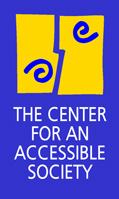
DISABILITY
ISSUES
INFORMATION
FOR
JOURNALISTS
ABOUT
THE CENTER
University grads with severe disabilities increase work chances through 'Illinois Model'
Note to readers: links to news articles may not work after a few weeks, as news media remove current stories to their archives. The link may take you to the archives section, where, for a fee, you can view the article.
Apr. 13, 2004 -- A Harris Poll in 2000 reported that only a third of working-age college graduates with disabilities were working full time for pay. Another 12 percent, the poll said, were working part-time.
Now a survey from the University of Illinois at Urbana-Champaign suggests that those figures can be raised dramatically.
Survey responses from 94 alumni with spinal cord injuries who graduated between 1978 and 2002 indicate that 79 percent of graduates with paraplegia and 70 percent of those with quadriplegia were employed. In addition:
- 92 percent had worked for pay in the past five years;
- 90 percent had graduate degrees;
- 73 percent had annual personal incomes greater than $35,000;
- 42.8 percent had annual personal incomes in excess of $50,000.
Brad Hedrick, the director of the university's Division of Rehabilitation-Education Services and principal investigator for the study, and Tanya Gallagher, the dean of the College of Applied Life Studies and the director of the Disability Research Institute, point to the the "Illinois Model" for educating students with disabilities as a principal reason for the higher figures.
The model, Hedrick said, "is born of a holistic philosophy that includes academic, physical, social and psychological supports." It includes intensive transitional orientation for students as well as job counseling, and the school is one of only three universities nationwide to offer personal-assistant services.
"Students also receive training in self-advocacy, and are encouraged to participate in seminars and/or to enroll in courses on the history and evolution of disability rights and nondiscrimination laws," say the researchers. "They learn strategies for improving their study and note-taking skills as well as time-management and organizational skills. Students also are afforded opportunities to take courses for academic credit to improve their information-technology literacy and proficiency in the use of state-of-the-art assistive information technologies, and to learn how to most effectively maximize their physical and mental health through the pursuit of proper nutrition and exercise."
More about the study can be found at http://www.eurekalert.org/pub_releases/2004-03/uoia-sla031904.php